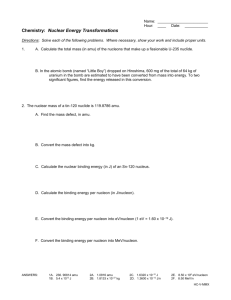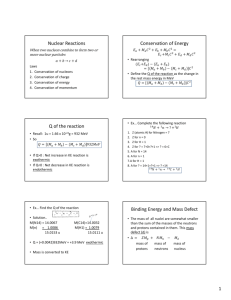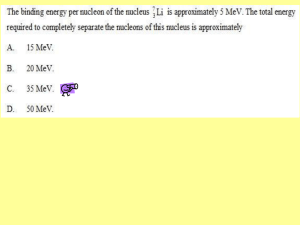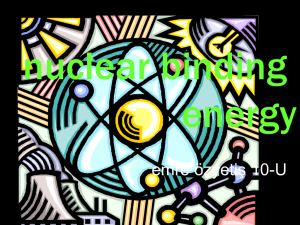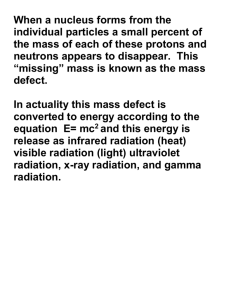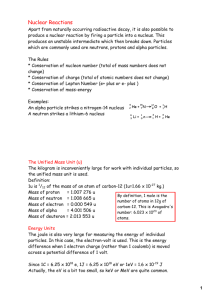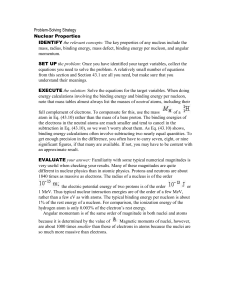Answer Key, Problem Set 10
advertisement
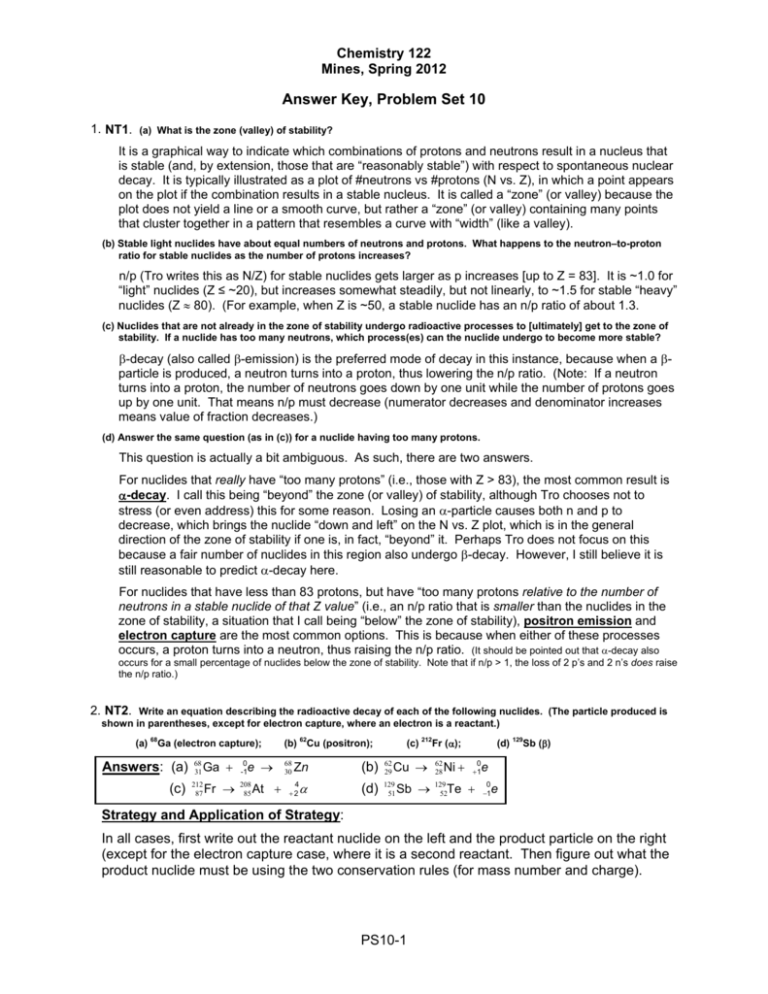
Chemistry 122 Mines, Spring 2012 Answer Key, Problem Set 10 1. NT1. (a) What is the zone (valley) of stability? It is a graphical way to indicate which combinations of protons and neutrons result in a nucleus that is stable (and, by extension, those that are “reasonably stable”) with respect to spontaneous nuclear decay. It is typically illustrated as a plot of #neutrons vs #protons (N vs. Z), in which a point appears on the plot if the combination results in a stable nucleus. It is called a “zone” (or valley) because the plot does not yield a line or a smooth curve, but rather a “zone” (or valley) containing many points that cluster together in a pattern that resembles a curve with “width” (like a valley). (b) Stable light nuclides have about equal numbers of neutrons and protons. What happens to the neutron–to-proton ratio for stable nuclides as the number of protons increases? n/p (Tro writes this as N/Z) for stable nuclides gets larger as p increases [up to Z = 83]. It is ~1.0 for “light” nuclides (Z ≤ ~20), but increases somewhat steadily, but not linearly, to ~1.5 for stable “heavy” nuclides (Z 80). (For example, when Z is ~50, a stable nuclide has an n/p ratio of about 1.3. (c) Nuclides that are not already in the zone of stability undergo radioactive processes to [ultimately] get to the zone of stability. If a nuclide has too many neutrons, which process(es) can the nuclide undergo to become more stable? -decay (also called -emission) is the preferred mode of decay in this instance, because when a particle is produced, a neutron turns into a proton, thus lowering the n/p ratio. (Note: If a neutron turns into a proton, the number of neutrons goes down by one unit while the number of protons goes up by one unit. That means n/p must decrease (numerator decreases and denominator increases means value of fraction decreases.) (d) Answer the same question (as in (c)) for a nuclide having too many protons. This question is actually a bit ambiguous. As such, there are two answers. For nuclides that really have “too many protons” (i.e., those with Z > 83), the most common result is -decay. I call this being “beyond” the zone (or valley) of stability, although Tro chooses not to stress (or even address) this for some reason. Losing an -particle causes both n and p to decrease, which brings the nuclide “down and left” on the N vs. Z plot, which is in the general direction of the zone of stability if one is, in fact, “beyond” it. Perhaps Tro does not focus on this because a fair number of nuclides in this region also undergo -decay. However, I still believe it is still reasonable to predict -decay here. For nuclides that have less than 83 protons, but have “too many protons relative to the number of neutrons in a stable nuclide of that Z value” (i.e., an n/p ratio that is smaller than the nuclides in the zone of stability, a situation that I call being “below” the zone of stability), positron emission and electron capture are the most common options. This is because when either of these processes occurs, a proton turns into a neutron, thus raising the n/p ratio. (It should be pointed out that -decay also occurs for a small percentage of nuclides below the zone of stability. Note that if n/p > 1, the loss of 2 p’s and 2 n’s does raise the n/p ratio.) 2. NT2. Write an equation describing the radioactive decay of each of the following nuclides. (The particle produced is shown in parentheses, except for electron capture, where an electron is a reactant.) 68 (a) Ga (electron capture); Answers: (a) (c) 68 31 Ga 0 -1 Fr 208 85 212 87 e At 62 (b) Cu (positron); 68 30 (c) Cu Zn (b) 62 29 (d) 129 51 4 2 212 Sb Fr (); 62 28 Ni (d) Sb () 0 1 Te 129 52 129 e 0 1 e Strategy and Application of Strategy: In all cases, first write out the reactant nuclide on the left and the product particle on the right (except for the electron capture case, where it is a second reactant. Then figure out what the product nuclide must be using the two conservation rules (for mass number and charge). PS10-1 Answer Key, Problem Set 10 (a) 68 31 Ga e 0 -1 Zn 68 30 In “electron capture”, the electron is a reactant. Sum of lower left subscripts on left is 31 + (-1) = +30, so it must be so on the right side as well (conservation of charge). Since there is only one product, 30 must be the number of protons in the product nuclide Zn. Mass number is 68 + 0 on the left, so it must be 68 on the right as well. In short: Conservation of Mass Number: 68 + 0 = x x = 68 31 + (-1) = y y = +30 Conservation of Charge: (b) 62 29 Cu 0 1 e 62 29 Cu 62 28 Ni 0 1 e In “positron emission”, the positron (positive electron) is a product. Conservation of Mass Number: 62 = x + 0 x = 62 Conservation of Charge: 29 = y + (+1) y = 28 Ni (c) Fr 212 87 or 4 2 4 2 4 2 212 87 Fr 208 85 At 4 2 He is a product. Conservation of Mass Number: 212 = x + 4 x = 208 +87 = y + (+2) y = +85 At Conservation of Charge: (d) 129 51 Sb 0 1 e 129 51 Sb Te 0 1 129 52 e is a product, and is an electron Conservation of Mass Number: 129 = x + 0 x = 129 Conservation of Charge: 51 = y + (-1) y = 52 Te 3. NT3. In each of the following nuclear reactions, supply the missing particle. 73 (a) Ga → (d) 241 73 Ge + ____ Cm + ____ → 0 1 Answers: (a) e 241 Am (b) 4 2 (b) 192 Pt → 188 (e) 137 Ba → 137 (c) 0 1 Os + ___ 205 Bi → 205 Pb + ___ Ba + ____ (d) e (c) 0 -1 (e) e Strategy and Application: In each case, I used the element symbols to find the elements on the periodic table to get the atomic numbers (#p’s; subscript). Then I used the conservation rules as noted above (Problem 2). (a) 73Ga → 73 Ge + ____ 73 31 Ga 73 32 Ge ____ 0 1 e Conservation of Mass Number: 73 = 73 + x x = 0 Conservation of Charge: 31 = 32 + y y = -1 Check: -emission is associated with a n → p conversion. Mass number stays the same, but proton number increases by one. That fits what happened here. (b) 192Pt → 188 Os + ___ 192 78 Pt 188 76 Os ____ PS10-2 4 2 Answer Key, Problem Set 10 Conservation of Mass Number: 192 = 188 + x x = 4 Conservation of Charge: 78 = 76 + y y = 2 Check: -emission is associated with a loss of 2 p’s and 2 n’s. Mass number decreases by 4, and proton number decreases by two. That fits what happened here. (c) 205Bi → 205 Pb + ____ 205 83 Bi 205 82 Pb ____ 0 1 e Conservation of Mass Number: 205 = 205 + x x = 0 Conservation of Charge: 83 = 82 + y y = +1 Check: positron emission is associated with a p → n conversion. Mass number stays the same, but proton number decreases by one. That fits what happened here. (d) 241Cm + ____ → 241 Am 241 96 Cm ____ 241 95 Am 0 -1 e Conservation of Mass Number: 241 + x = 241 x = 0 96 + y = 95 y = -1 Conservation of Charge: Check: Electron capture is associated with a p → n conversion. Mass number stays the same, but proton number decreases by one. That fits what happened here. (e) 137Ba → 137Ba + ____ 4. NT4. Gamma emission does not change the identity of the nuclide. (a) The only stable isotope of fluorine is F-19. Predict possible modes of decay for F-21, F-18, and F-17. (b) Also 210 195 predict possible modes of decay for Po and (c) Au. Answers, with most brief explanations: (a) F-21, too many neutrons -decay (actual is F-18 and F-17, too few neutrons positron emission or electron capture (b) Po-210, Z > 83 -decay (actual is (actual is P.E. for both) (c) Au-195, too few neutrons positron emission or electron capture (actual is EC Strategy, General Approach (with Explanation): 1) Look to see if the number of protons is greater than 83. If it is, predict alpha decay (even though this won't always be the actual decay). If p is less than (or equal to) 83, then: 2) First calculate the n/p ratio for the nuclide (although see Note in #2 below for the absolute “quickest” approach, although you need to make sure you don’t forget what an n/p ratio is!). 3) Then assess the approximate "stable" n/p ratio for the proton number of the nuclide that you're dealing with. (I.e., find out "where you are" on the "zone of stability" plot.) Note: As I mentioned in class (and as Tro mentions on p. 873), there is another (“shortcut”) way to get a rough idea of where the approximate “stable” n/p ratio for a nuclide is. You can look at the average atomic mass of the element on the periodic table, round it to the nearest integer, and assume that the nuclide with that mass number is likely to be stable! For example, I told you that near Z = 83, the stable n/p ratio is about 1.5. If you look at Au, and round its average atomic mass of 196.967 up to 197 and take that as the mass number of a stable nuclide of Au (which has 79 p’s in every nucleus), the number of neutrons in that nuclide would be 197-79 = 118, and thus the n/p ratio would be 1.49, which is very close to 1.5! This works most of the time because the average atomic mass is the weighted average of the naturally occurring isotopes on Earth, which means those isotopes that are reasonably stable and thus lie in or near the zone of stability. 3) Compare the actual n/p ratio of each nuclide with the "stable" n/p ratio to see whether or not it has "too many neutrons" (actual n/p larger than "stable" n/p) or "too few neutrons" (actual n/p smaller than "stable" n/p). Then you can make your conclusion: PS10-3 Answer Key, Problem Set 10 a) If there are "too many neutrons" to be stable, the nuclide is expected to turn a neutron into a proton, which is associated with beta decay. b) If there are "too few neutrons" to be stable, the nuclide is expected to turn a proton into a neutron, which is associated with either positron emission or electron capture. NOTE: Alpha decay is also a possibility since it will also get you somewhat closer to the zone of stability, but it is much rarer, and you need never predict it. Application of Strategy: (a) For the F example, clearly Z < 83 since Z = 9. So no -decays are predicted. There is no need to calculate an n/p ratio since they tell you that the only stable isotope is F-19. That being said, F-21 must have “too many neutrons” to be stable, and so -decay (n → p) is predicted. And similarly, F-17 and F-18 must have “too few neutrons”, and so positron emission or electron capture are predicted. (b) For 210Po, the atomic number is 84, so -decay is predicted. (c) For 195Au, the atomic number is 79 which is < 83, so no -decay is predicted. Using the “shortcut” method, the assumed stable isotope of Au is Au-197 since the average atomic mass is close to 197 amu. So Au-195, which has fewer neutrons than in Au-197, is predicted to have “too few neutrons” and is predicted to decay by the process that turns a p into an n—positron emission or electron capture. If asked to consider the n/p ratio, you should be able to do so. Here, n/p = (195 – 79)/79 = 1.47. 79 is very close to the “end of the line” which is at Z = 83 and at which n/p is close to 1.5. Although you might say this one is “too close to call”, if pushed to guess, you’d have to say that n/p was too small—it clearly isn’t too large! So again, you’d predict the decay that would turn a proton into a neutron. 5. NT5. Complete the following nuclear reactions. [All have been used to synthesize elements.] 1 12 1 (a) ____ 42 He 243 (b) 238 97 Bk 0 n 92 U 6 C ____ 6 0 n (c) 249 98 Cf ____ 240 95 Answers: (a) Am 260 105 (b) (d) Db 4 01 n 244 98 Cf (c) 15 7 249 98 N Cf 10 5 B 257 103 Lr 2 ____ (d) 01 n Work / Reasoning (using conservation rules as in Problem 2): (a) ____ 4 2 He 243 97 Bk 1 0 n Answer: 240 95 Am Conservation of Mass Number: x + 4 = 243 + 1 x = 244 – 4 = 240 (b) 238 92 Conservation of Charge: y + 2 = 97 + 0 y = 97 – 2 = 95 Am U Answer: 12 6 C ____ 6 01 n 244 98 Cf Conservation of Mass Number: 238 + 12 = x + 6(1) x = 250 – 6 = 244 Conservation of Charge: (c) 249 98 Cf ____ 260 105 Db 4 01 n 92 + 6 = y + 6(0) y = 98 Cf Answer: 15 7 N Conservation of Mass Number: 249 + x = 260 + 4(1) y = 264 – 249 = 15 Conservation of Charge: (d) 249 98 Cf 10 5 B 257 103 Lr 2____ 98 + y = 105 + 4(0) y = 105 – 98 = 7 Answer: 1 0 n Conservation of Mass Number: 249 + 10 = 257 + 2x 2x = 259 – 257 = 2 x = 2 Conservation of Charge: 98 + 5 = 103 + 2y 2y = 103 -103 = 0 y = 0 PS10-4 Answer Key, Problem Set 10 6. NT6. -1 Radioactive copper-64 decays with a half-life of 12.8 days. (a) What is the value of k in s ? (b) A sample 64 contains 28.0 mg Cu. How many decay events will be produced in the first second? Assume the atomic mass 64 64 of Cu is 64.0 (amu). (c) A chemist obtains a fresh sample of Cu and measures its radioactivity. She then determines that to do an experiment, the radioactivity cannot fall below 25% of the initial measured value. How long does she have to do the experiment? Answers: (a) 6.27 x 10-7 s-1 (b) 1.65 x 1012 dps (c) 25.6 days Work/ Reasoning: -1 (a) What is the value of k in s ? k ln 0.5 0.693 t 1/2 t 1/2 0.693 6.266 x 10 -7 s -1 6.27 x 10 - 7 s -1 24 h 60 min 60 s 12.8 d x x x d h min Remember: All nuclear decays are first order, so the above relationship applies. 64 (b) A sample contains 28.0 mg Cu. How many decay events will be produced in the first second? Assume the 64 atomic mass of Cu is 64.0 (amu). First order R = kN. or A = kN NOTE: In this key, A is often used for rate because (radio)activity is often used as a synonym for “rate of decay”). Since we know k (part (a)), to get R at any given time, we just need N at that time. In the first second, N is the initial value—i.e., the number of nuclei in the 28.0-mg sample of 64Cu: 28.0 mg x 0.001 g 1 mol 6.022 x 10 23 atoms Cu 1 nucleus 2.635 x 10 20 x x x atom mol atoms 64.0 g mg A = 6.266 x 10-7 s-1 2.635 x 10 20 (c) 64 64 Cu nuclei (at t = 0) Cu nuclei 1.651 x 1014 dps (or cps) 64 A chemist obtains a fresh sample of Cu and measures its radioactivity. She then determines that to do an experiment, the radioactivity cannot fall below 25% of the initial measured value. How long does she have to do the experiment? Explanation, Quick Way (for this problem, because of a special case) For first order nuclear processes, the half-life is a constant (because it is first order). Thus, the time it takes for the number of radioactive nuclei to become half of what it was originally is “one half-life”, and the time it takes for the number to become one half of that, or ¼ the original, is “two half-lives”. Since decay rate is proportional to number of nuclei, it also takes two half-lives for the sample’s decay rate (radioactivity) to drop to ¼ (=25%) of its original value. So in this problem, the chemist has two half-lives’ worth of time to do her experiment. Since the half-life is given as 12.8 days, she has 2 x 12.8 = 25.6 days. Explanation, More General: A more general solution, particularly useful when the time is not an integral number of half-lives, is as follows. Whenever you have a question that relates “time” and “amount (or fraction) remaining”, you should recognize that the appropriate equation to use is the “integrated rate law”, and you should UNDERSTAND THE MEANING OF THIS EQUATION, as well as keep track of units (as always!): Fraction of radioactive nuclei remaining at time t Nt e kt No Remember that there are other equivalent “versions” of this equation. For example, Tro uses N ln t No kt Equation [19.3] ALSO remember that since the activity (decay rate) is proportional to the amount of nuclide present (A = kN), the ratio of activities is equal to the ratio of “number of nuclei”. That is: PS10-5 Answer Key, Problem Set 10 At kNt Nt e kt Ao kNo No or in other words, At e kt Ao This means that the fraction of the activity remaining can be used in the integrated rate law just like “fraction of nuclei remaining” is. In this problem, the % remaining is 25%, which equals 0.25 in terms of a fraction (or decimal). Thus: 0.25 e ( 6.27 x 10 2.21 x 10 6 s x -7 s-1 )t ln(0.25) = -(6.27 x 10-7 s-1)t t = ln(0.25) 2.21 x 106 s 6.27 x 10 - 7 s-1 1 hr 1 day 1 min x x 25.6 days (which is the same answer as above [2 x t1/2]) 60 s 60 min 24 hr 7. NT7. 3 Fresh rainwater or surface water contains enough tritium ( 1H ) to show 5.5 decay events per minute per 100. g of water. Tritium has a half-life of 12.3 years. Pretend that the year is 2009 (rather than the current year). You are asked to check a vintage wine that is claimed to have been produced in 1946. How many decay events per minute should you expect to observe in 100. g of that wine? (Again, assume it is 2009 right now.) Answer: 0.16 dpm Reasoning/Work: One needs to look at this is as a variant of a “What is t?” kind of problem. That is, typically in this kind of problem we want to “date” something. So the question really becomes “How long has it been decaying?” The answer, which is a time, ends up being an “age”. And that time is the “t” in 0.693 t At 0.693 t kt the integrated rate law: , because k for first order processes . In this problem, e e Ao t 1/2 however, we are not asked for time, but effectively are given the time and asked to predict a value of activity. The same integrated rate law applies. The only “thorny” issues here are that you have to make some assumptions to solve the problem. One is that you have to assume that 100. g of wine is essentially 100% water, which is obviously not true, but is probably not too far off (our bodies are mostly [but not 100%!] water as well!). Also, you must assume that the water ultimately got into the wine via rainwater or surface water (because it came from grapes, which got their water from “nature” as the vines grew). The idea is that once the wine is bottled, no new water gets added, so the tritium in the water just decays as the wine sits. The activity will go away at a rate dictated by its k (and thus half-life), and thus “now” (i.e., in 2009) the rate will be lower than it was originally since there aren’t as many radioactive nuclei left (since they’ve been decaying since 1946—about 63 years!). The activity “now” will be related to the original activity (which is assumed to be equal to the current activity of “fresh” rainwater) by the integrated rate law, so you can plug into that equation as follows to find the current (2009) activity (predicted): 1/ 2 0.693 t t1 / 2 Anow e Ao 8. NT8 0.693 0.693 2009 1946 y 63 y Anow 12.3 y 12.3 y e Anow 5.5 dpm e 0.158 0.16 dpm 5.5 dpm 14 12 Assume a constant C/ C ratio of 13.6 counts per minute per gram of living matter. A sample of petrified tree 14 was found to give 1.2 counts per minute per gram. How old was the tree? (t1/2 of C is 5730 years.) Answer: 20100 y Work/Reasoning: Use the integrated rate law again, as in the prior two problems. The ratio of activities is equal to e-kt: PS10-6 Answer Key, Problem Set 10 0.693 t t1 / 2 Anow e Ao 0.693 t 1.2 cpm e 5730 y 0.08824 e 0.0001209 y t 13.6 cpm -1 ln(0.08824) = -(0.0001209 y-1)t t = -2.4277 20080 y 20100 y - 0.0001209 y -1 9. NT9. A small atomic bomb releases energy equivalent to the detonation of 20,000 tons of TNT; a ton of TNT releases 9 13 235 4 x 10 J of energy when exploded. Using 2 x 10 J/mol as the energy released by fission of U, (a) approximately 235 what mass of U undergoes fission in this atomic bomb? (b) Does the bomb have more mass or less mass after the explosion? By how much (in mg)? (a) 20000 ton TNT x 4 x 10 9 J 1 mol 235 U 235 g x x 940 g ton TNT 2 x 1013 J mol 235 U 235 U (b) Answers: Less mass; ~900 mg less Reasoning: Because of the concept of “mass / energy interconversion” (Einstein), when energy leaves a system, mass is lost as well! We interpret Einstein’s E = mc2 equation to mean that when energy leaves a system, it is said to have come from the conversion of a little bit of its mass. Conversely, when energy is added to a system, mass is added. Any exothermic process must be associated with a mass loss in the system; any endothermic process results in a main gain. The magnitude of the mass loss/gain depends on the change in energy according to: E = mc2. In this case, E = -20000 ton x (4 x 109 J/ton) = -8 x 1013 J (sign is negative because process is exothermic), so: m E 8 x 1013 J c2 2.9979 x 10 8 m/s - 0.000890 kg x 2 0.000890 kg 1000 g 1000 mg x 890 900 mg 900 mg was lost kg g The negative sign indicates that 900 mg of mass were lost (converted into energy) when the bomb exploded (reacted). That’s nearly 0.1% of its mass! That is not insignificant! 10. NT10. (a) What is meant by the terms “binding energy” and “mass defect”? Binding energy (Eb [my abbreviation]) is the energy required to break apart a nucleus completely into free protons and neutrons. Mass defect is the mass increase that occurs when a nucleus is completely broken apart into free protons and neutrons (or the mass loss that accompanies the formation of a nucleus from free protons and neutrons). NOTE: Tro’s definition is consistent with mine, although he phrases it differently, as the “difference in mass” between a nucleus and the “sum of the separated particles”. (b) Describe clearly in words how you could calculate the binding energy for a nuclide using the precise masses of a nuclide as well as the mass of a (free) proton and a (free) neutron. Hint: write out the nuclear equation corresponding to the binding energy. Binding energy and mass defect are associated with the same process (described in part (a)). For a nuclide with Z protons, and A – Z neutrons (A is the mass number), the equation that represents the process associated with both BE and mass defect is: X Z11p (A - Z)01n ; E E b , d n a A Z m mass defect Since Eb and m are associated with the same process, they must be related by E mc2 for a given nuclide (In fact, this is how Tro defines (nuclear) binding energy). Thus, to calculate binding energy (if the mass of the nuclide is known), write out the equation corresponding to the break up of the nucleus of interest into its constituent nucleons. Find the difference in mass between the (sum of PS10-7 Answer Key, Problem Set 10 the masses of the) free nucleons and the mass of the nucleus. Then calculate binding energy using (Eb ) E = mc2 (being careful with units! ) 11. NT11. (a) What is the difference between fusion and fission? (define each) Fusion refers to the process in which two (or more) nuclei come together to form one (larger) nucleus. Fission refers to the process in which one nucleus splits apart to form two (or more) smaller nuclei. (b) If the binding energy of Ar-40 is 343.8 MeV, what is the binding energy per nucleon? Eb binding en ergy 343.8 MeV 8.595 MeV/nucleon nucleon number of nucleons 40 nucleons NOTE: The number of nucleons equals the mass number (A), since A n + p (by definition) (c) What is the difference between “binding energy” and “binding energy per nucleon”? Which one helps you predict whether or not a nuclide will undergo fission or fusion to lower its energy? Binding energy is defined in NT10; the binding energy per nucleon is the binding energy for a particular nuclide divided by the number of nucleons in the nuclide (see part (b) above). It is the binding energy per nucleon which indicates how thermodynamically stable a nuclide is (compared to other nuclides). If the binding energy per nucleon for a nuclide is smaller than the maximum in Figure 19.12, then the nuclide is not as stable as it could be by either breaking up (if the nuclide has a mass number larger than ~56) or fusing together with another (if the nuclide has a mass number smaller than ~56). (d) Do larger nuclides always have larger binding energies? Do larger nuclides always have larger binding energies per nucleon? Answers: Yes, No Explanation / Reasoning: Larger nuclides always have larger binding energies than smaller nuclides (because with each “extra” nucleon added / bound, energy must be lowered [because nucleons attract one another!]), but they do NOT always have the largest binding energy per nucleon. After a certain point, it becomes less stable (per nucleon) to continue to get bigger. This is what is shown in Figure 19.12. There may seem to be a discrepancy here, but there isn’t. Comparing the binding energy of one nucleus of U-238 to one nucleus of Fe-56 is like comparing “apples to oranges” since the number of nucleons is not the same. So even though U-238 has a larger binding energy than Fe-56, it is not “more stable” because if the nucleons were rearranged into four Fe-56 nuclei (plus some extra nucleons), energy would be lowered. How can you know this without actually calculating the E for this hypothetical reaction? You just look at the binding energy per nucleon and that tells you this must be true! If the same number of nucleons is involved, it is clear that the nucleus having the larger binding energy per nucleon will be the “lower-energy” (overall) arrangement of nucleons. (because E/nucleon x # nucleons Eoverall). But even if the number of nucleons is not the same, the Eb per nucleon will reflect intrinsic “stability” of a nucleus. LOOK AT THE POWERPOINT SLIDES IN WHICH I ASK “WHAT IS THE MOST STABLE WAY TO ARRANGE 30 (OR 240) NUCLEONS” TO HELP MAKE THESE IDEAS CLEAR TO YOU. (e) Of the nuclides in the table shown on the first page of this PS10 sheet, which one(s) are more thermodynamically stable than Ar-40? [see part (b)] (Note: You may need to calculate some values omitted from that table.) Answer: Ni-60 is the only one, since it is the only one that has a Eb/nucleon greater than 8.595 MeV/nucleon. Note: You had to calculate the Eb/nucleon values for three of the nuclides in the table by dividing Eb by the mass number ( # of nucleons)—I put those in bold underlined italics in the table to the right. PS10-8 Nuclide He-5 Be-10 N-15 Mg-30 Ni-60 Cd-120 Cm-240 Mass # 5 10 15 30 60 120 240 Eb (MeV) 24.41 64.98 115.49 241.6 526.8 1015 1810 Eb/nucleon 4.88 6.50 7.70 8.05 8.78 8.46 7.54 Answer Key, Problem Set 10 12. NT3. 3 1 2 3 2 (a) Calculate the binding energy per nucleon for 1 H and 1 H . The atomic masses (in amu) are 1 H , 2.01410, and H , 3.01605. melectron 0.000549 amu; mp 1.00728 amu; mn 1.00866 amu Answers: 2 1 H , 1.78 x 10-13 J OR 1.11 MeV 3 1 (per nucleon) H , 4.53 x 10-13 J OR 2.83 MeV (per nucleon) Strategy: 1) Write out the balanced equation corresponding to breaking up the nuclide into free nucleons. 2) Find m mnucleons - mnuclide . NOTE: When matom (atomic mass) is given, I find mnuclide by subtracting the mass of the electrons from matom: mnucleus [w/o e’s] matom [w/ e’s] - melectrons. This is how I did it in class. I find this more straightforward than what Tro does. Tro uses the mass of an H atom in place of the mass of a proton, and then uses the mass of the atom (without subtracting away the mass of the electron(s)): m mH atoms + neutrons - matom 3) Convert m (which will be in units of amu [per nucleus]) into kg [per nucleus] using: 1 amu = 1.6605 x 10-27 kg (to 5 SF) 4) Substitute into E = mc2 (here, it ends up being Eb m.d. x c2). Recognize that units will be J (if c is used in units of m/s and m.d. in kg), and that this is still per nucleus. 5) For binding energy per nucleon, recognize that you must divide Eb by the number of nucleons. You can do that at this point if you want the result in J/nucleon. If you want the result in MeV/nucleon, you can convert J to MeV first, and then divide by the number of nucleons. (Actually, it doesn’t matter the order in which you do the conversion from J to MeV. I just prefer to do my “division by the # nucleons” last.) Use: 1 MeV = 1.6022 x 10-13 J Execution of Strategy for 21H : 2 1 H p 1 1 1 0 n; E Eb ( 12H ), and m mass defect(of 12H ) m.d. m m (1p + 1n) - mH-2 nucleus (1.00728 + 1.00866) – (2.01410 – 0.000549) 0.002389 amu Convert to kg: 0.002389 amu x 1.6605 x 10 -27 kg 3.9669..x 10 - 30 kg (per nucleus) amu Eb m.d. x c2 (3.966.. x 10-30 kg)(2.9979 x 108 m/s)2 3.565.. x 10-13 J (per nucleus) Eb per nucleon = 3.565 x 10 -13 J 1.7825 x 10 -13 1.78 x 10-13 J/nucleon 2 nucleons OR (converting Eb to MeV first): Eb = 3.565.. x 10 -13 J x Eb per nucleon = MeV 2.225.. MeV (per nucleus) 1.6022 x 10 -13 J 2.225.. MeV 1.112.. 1.11 MeV/nucleo n 2 nucleons PS10-9 (Note: this matches the value in Fig. 19.12) Answer Key, Problem Set 10 Execution of Strategy for 31H : H 3 1 p 2 01n 1 1 m.d. m m (1p + 2n) - mH-3 nucleus (1.00728 + 2(1.00866)) – (3.01605 – 0.000549) 0.009099 amu Convert to kg: 0.009099 amu x 1.6605 x 10 -27 kg 1.5108..x 10 - 29 kg (per nucleus) amu Eb m.d. x c2 (1.5108.. x 10-29 kg)(2.9979 x 108 m/s)2 1.357.. x 10-12 J (per nucleus) Eb per nucleon = 1.357 x 10 -12 J 4.526.. x 10 -13 4.526 x 10 - 13 J/nucleon 3 nucleons OR (converting Eb to MeV first): Eb = 1.357.. x 10 -12 J x Eb per nucleon = MeV 8.475.. MeV (per nucleus) 1.6022 x 10 -13 J 8.475.. MeV 2.825.. 2.83 MeV/nucleon 3 nucleons 2 3 (b) Which nuclide is more thermodynamically stable, H or H? Explain briefly. Answer: 3H is more stable. Explanation: A greater Eb per nucleon means “more thermodynamically stable”. It represents an average amount of “energy lowering” per nucleon in that particular nucleus, and lower energy (per nucleon) implies more stable. 3 3 NOTE: In this case, the Eb itself also happens to be greater for H but that is not why H is more stable. One must always compare Eb per nucleon to assess relative thermodynamic stability of two nuclei. PS10-10
